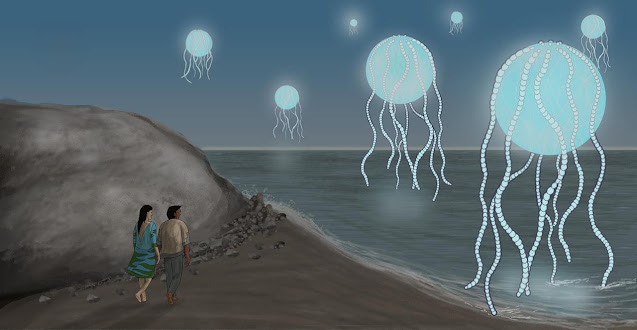From Atoms to Animals (Part 5) - One Cell To Many
Today there are many single-celled organisms: bacteria, amoebas, yeast, etc. but many forms of life we are familiar with are multicellular. The next question we need to answer is: How do a large number of cells decide to band together to form one, big animal like a dog or a dolphin?
Well, we can find some clues by looking at today’s natural world. Some species of single-celled bacteria and fungi can form ‘colony’ structures. The humble slime mold is an organism that spends most of its time in a unicellular state, but when conditions change (for example, when food is scarce), these single-celled individuals clump together to form a much larger entity, capable of moving to an area with better foraging prospects. This compound organism is also sensitive to airborne chemicals and can detect food sources. It can change shape and function of different parts, forming stalks that produce spores for reproduction.
It is possible that early colonies of unicellular organisms survived better in their combined form than they did as individual units, and so evolved to stay permanently in the multicellular state.
Here again we see natural selection at work. The more successful (multicellular) forms naturally become more numerous than the less successful (unicellular) forms. If you have a feature of any kind that makes it easier for you to survive in some way, such as being able to move to an area where there is more food, you will therefore live longer and therefore have more offspring compared to someone who does not have that advantage. Within a few generations your offspring will outnumber those of your less successful contemporaries.
The earliest multicellular fossils are from 3.5 billion years ago, of organisms resembling cyanobacteria forming filaments and mats.
Around 2 billion years ago, photosynthesis from cyanobacteria (and possibly their multicellular descendants) lead to the Great Oxidation Event in which Earth’s environment (in the air and ocean) became filled with oxygen. This was a more supportive environment for larger multicellular animals which need greater concentrations of oxygen to sustain their tissues. The proliferation of oxygen would also have led to the formation of the ozone layer, shielding the surface of the Earth from harmful solar radiation.
More complex multicellular organisms (metazoans) began to appear during the Ediacaran Period (around 635–538 million years ago). These living things came in a variety of shapes; tubular, bag-shaped, plant-like and creatures resembling worms and slugs, mostly in the ocean.
The Cambrian Explosion approximately 538.8 million years ago was the relatively sudden and rapid development of more complex life in the ocean, much of it resembling modern animals. This included the first fish and also arthropods, the class of animals which includes modern crustaceans (crabs, lobsters, etc.).
Evolution on this scale is driven by complex factors, with natural selection still being the most significant. In any population of animals, there will be some variations in body features. Not all offspring of one mother will be identical. One may have a slightly longer neck, slightly better eyesight, etc. If that feature gives the animal a survival advantage (for example, being better able to see its prey), that animal will hunt better, and so eat more, and so live longer, and so have more offspring than its less-advantaged siblings. After a few generations, there will be many more of these ‘fitter’ animals compared to those who do not have this advantage.
After many more generations there will be many more opportunities for other advantageous features to arise and be preserved via natural selection, and at some point the descendant will be very different from its distant ancestor. It will be a new species.
The first plants evolved around 470 million years ago, the earliest known type being a form of algae (which probably evolved from photosynthetic cynaobacteria). The earliest land plants date from around 400 million years ago. At about the same time insects began to evolve (probably from crustaceans).
About 380 million years ago one class of fish (Sarcopterygii) evolved into amphibians: the first four-legged, air-breathing land animals (‘tetrapods’). From amphibians the first reptiles evolved around 310 million years ago. For millions of years, reptiles were the dominant land animals of our planet, in the form of dinosaurs.
Birds evolved from reptiles around 200 million years ago. Mammals also evolved from reptiles around the same time.
Dinosaurs became extinct following a meteorite strike about 66 million years ago. Today the crater from this impact measures 180km in diameter, the Chicxulub crater underneath the Yucatán Peninsula in Mexico. The impact produced more than a billion times the energy released by the atomic bombs dropped on Hiroshima and Nagasaki at the end of World War II, creating a dust cloud that enveloped the whole Earth and blocked out the sunlight. This caused a ‘nuclear winter’ as the temperature dropped and plants died from lack of photosynthesis. This extinction event wiped out three quarters of all plant and animal species on Earth.
Smaller animals, which included mammals, were more able to adapt and soon began to fill the gaps left by the dinosaurs. Without the dinosaur apex predators, mammals thrived and larger species developed.


Comments
Post a Comment